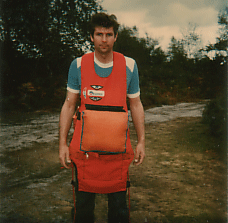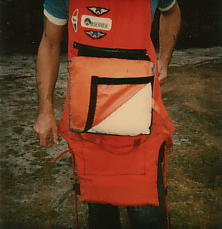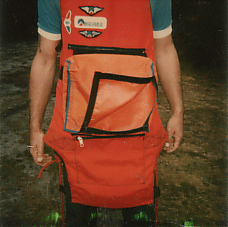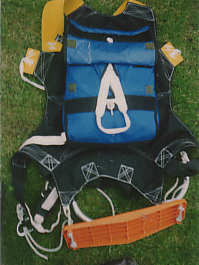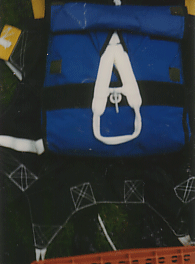Accidental Parachute Deployment
I was asked to explain what happened when my parachute accidentally deployed during a BHGA annual flying Championship held at Mere
How I became the first person in the UK to land by Parachute from a Hang Glider, although it was not by choice
During one of the distance competitions, I had been drawn to fly against Judy Leden (who later went on to become the Woman's World Champion). I had also drawn the long straw and choose to take off first. For those who do not under stand the significance of my choice. The flyer who goes first has the choice of picking when they want to take off, and in most cases the first flyer will try and wait for a thermal of rising air to come up the face of the take off hill. If you let the gust of wind go through, hopeful you will then be in what is known as still air and is know as the eye of the thermal. The pilot then waits for the wind to start blowing once again which signals the other side of the thermal. They would then try and time their take off to catch the last gusts of wind as the thermal goes through. They will then be able to take off into rising air knowing that the flyer behind him will be unlucky and not be able to take off in rising air. Thus the first flyer would gain height to fly further while the second flyer would usually just glide down to the landing field at the base of the hill. To make the rules a little clearer, the first flyer usually had about 5 minutes in which to take off, while the second flyer had to follow the first flyer within about 30 seconds. I must also add that all this happened around the late1970s early 80s and that the rules and flying characteristics of the Hang Gliders were constantly changing and I'm not sure how it all works today. Maybe somebody might like to let me know.
Anyway I let the first gust of wind go through then picked up my hang glider and walked to the face of the hill and waited for the eye to also pass through, then when I thought I was using the wind advantage, I ran forward and took off. Usually it take you a couple of minutes to get your self comfortable and in a position to take advantage of the take off position. I believe that by this time I was above the take off point and out the front of the hill at about 800 feet from the ground at the bottom of the hill. Within just a few Minutes I heard what I can only describe as a Woosh noise. My first reaction was to look up believing that the sail had just been ripped from the glider. Only to be amazed that it was all in tack and in place. The brain was working over time wondering what the hell it was. When I looked down I could see that the parachute was hanging below me, and about to disappear behind me. It happened so fast that I did not have time to do anything. As the chute went behind me it opened up and fully deployed. One minute I'm flying forward at about 20mph, the next it was like being attached to a bung cord, because i felt as through I was going backwards. Within seconds and as the glider lost its air speed it suddenly dropped and I found myself heading towards the ground with both the nose of the glider and my head going down first. Lucky it felt like slow motion as it gave me time to think. And it did not take me long to realise that hitting the ground head first was not going to be in my best interest. I managed to turn myself around so I was now going down feet first. Its amazing that I managed to turn around because the hanging strap of my harness that is hooked to a hang point on the keel near where the A frame is bolted to the keel, and is not very long. My next worry was that my feet were hanging below the bottom of the A frame bar. I don't know why but I believed that the bottom of the A frame bar might cut my feet off or at lest break them. So I climbed into the A frame and crouched on the bottom of the bar holding on at the hang point. By this time the ground was rushing up at me and as I hit I pushed the hang point away from me trying to protect my face. At that time there was another thermal coming through and it kept the parachute inflated which started to drag me across the landing field. Lucky for me several other flyers rushed over to help and deflate the chute. Cant believe I got away with only damaging the bracket that attaches the A frame to the keel of the glider. Oh and a broken sternum although I have no idea how that happened, but several flyers believed as I was in crouched position my knees came up and hit my chest. I also had a large broken pride, because as I lay on the ground and looked up, I watched Judy fly past me and not only win the duel against myself, but the whole event.
There was a little good that came out of this incident. At that time Parachutes were new and many people didn't believe they would open in time to save them. I believe I was only about 800 feet above the ground when the chute accidentally fell out of the deployment bag and would have saved me from major damage if the glider had broken up during the flight. From that day the sale of parachutes increase dramatically. I must also add that my chute like many others at that time was attached to the underneath of the glider near where the A frame is attached to the keel. Which is why I ended up in a head down position. From that day flyers attached their parachutes to the same position but from the top of the glider. My parachute had been brought in from America and was just a simple bag using Velcro on three side to keep it closed. MainAir and another company completely re-designed the deployment bag and the photos below explain how mine malfunctioned and what the next generation looked like.
This is how the parachute container should look before take off. All neatly packed and all three sides of the velcro completely stuck down. Although exaggerated, this is how the corner peeled away as it rubbed on the bottom of the A frame on my glider, as I ran to take off This photo shows the container after the parachute have dropped out and deployed. Accidental I might add. Although I should have checked it before I ran to take off. Hindsight!!!
The above are a couple of English Parachutes designs that were released onto the market after what happen to me at Mere. Note the plastic seat that we used to sit on in the early days and were later re-used as a means of supporting our legs when hanging in the Prone Harness.
